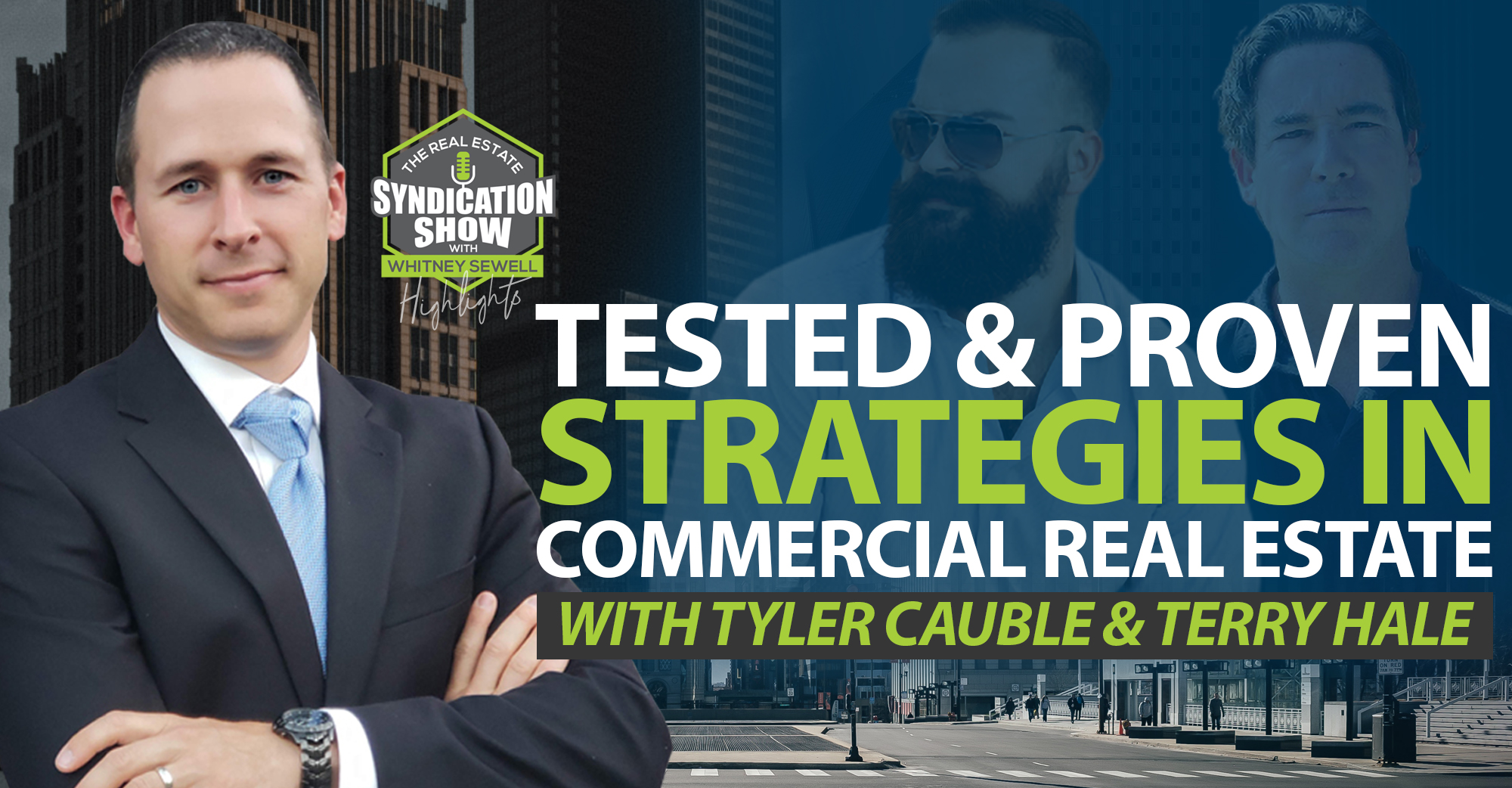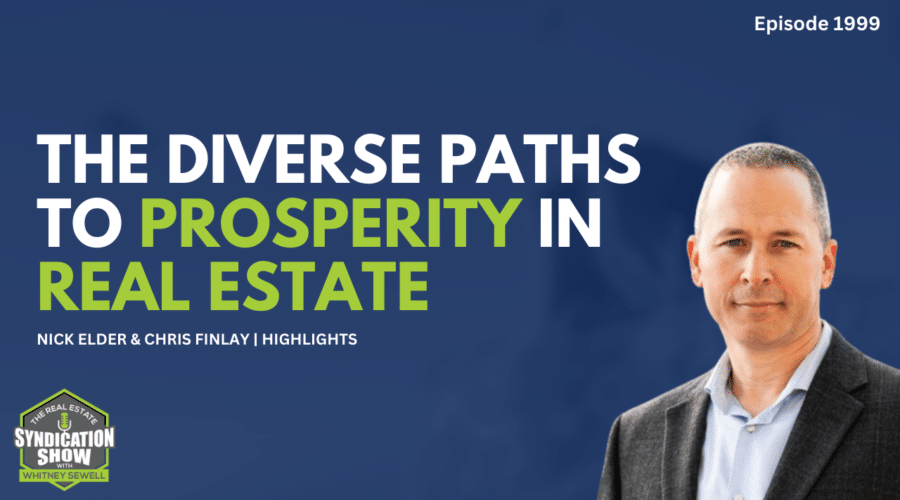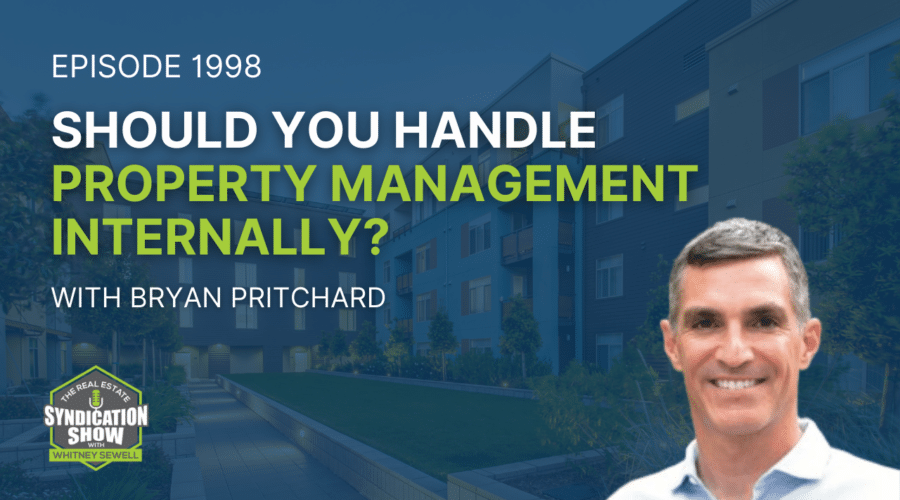Running a commercial real estate business requires systems and practices that will ensure profitability. In this Highlights episode, we look back at our conversations with Tyler Cauble of The Cauble Group and best-selling author of Open for Business: The Insider’s Guide to Leasing Commercial Real Estate, and Terry Hale of Wealth Training Group, Inc.
How to Start Investing in Multifamily Real Estate
If you’re interested in multifamily real estate but don’t know where to begin, our guide “How to Start Investing in Multifamily Real Estate” breaks down everything you need to know about identifying good investments plus real world examples. Download your copy in the show notes or visit lifebridgecapital.com/startnow to start your journey in multifamily real estate.
Watch the episode here:
Listen to the podcast here:
Tyler unpacks the building of a team, a central part of how he has moved forward in this work before we get into the particulars of his first big syndication deal! While Terry touches on location, pulling in cash flow, and creating dependable structures as the things you should look for in commercial real estate. Click the play button now and learn some proven and tested strategies in commercial real estate!
Key Points From This Episode:
- A little bit about Tyler’s team and how he partnered up.
- The closing of that deal and lining up the next steps in the process.
- Tyler’s tips on leasing up an office and retail space!
- The hardest part of syndication; the eternal struggle of raising capital.
- How Terry learned and became successful in his niche.
- Hear about Terry’s three-prong style of business.
- Some of the vital questions Terry asks himself and his clients.
- Why time is your most valuable asset and why you should avoid a shotgun investing approach.
- Terry tells us about a recession-proof property.
- The reasons why self-storage is such a low-risk investment.
- Hear about Terry’s book The Two Best Strategies to Profit with Commercial Real Estate.
- How Terry uses the cap rate formula when making deals.
Tweet This!
“I think the most important thing when going through that process is to have a team. I mean, it’s just like syndicating. You have to have a team of individuals that are helping you do it all.” — Tyler Cauble
“I would say make sure you have a really good attorney on your side. I can’t tell you how many times I’ve seen landlords just Frankenstein contracts, leasing contracts off of stuff they’ve found online. That is such a nightmare.” — Tyler Cauble
“The other thing too when it comes to leasing, don’t go for the maximum amount rate that you think you can.” — Tyler Cauble
“You want to intrigue them so much that they ask to invest in your deals.” — Tyler Cauble
“Time is your most precious asset.” — Terry Hale
“It takes time, and I’m sure your listeners that are out there being investors, they know. They have to pick and choose the right deals. If you don’t, then you could end up taking over a headache that can’t be cured.” — Terry Hale
Links Mentioned in Today’s Episode:
WS358: Leasing Up Commercial Real Estate with Tyler Cauble
WS787: The Best Strategies to Profit with Commercial Real Estate with Terry Hale
About Tyler Cauble
Tyler Cauble is Founding Principal and President of The Cauble Group, an East Nashville-based commercial real estate brokerage serving the Greater Nashville Area. He’s a native Nashvillian that has not only been a witness to the city’s tremendous growth but is also involved in it through his developments, renovation projects, and volunteer work with the Real Estate Investors of Nashville and the Nashville Junior Chamber. As President of The Cauble Group, Tyler helps bring together buyers, sellers, landlords, and tenants in retail, office, industrial, and multi-family real estate. He’s committed to helping business owners understand the market so that they can grow their business and be part of Nashville’s future. Cauble is also the best-selling author of Open For Business: The Insider’s Guide to Leasing Commercial Real Estate.
About Terry Hale
Terry Hale is an author of educational curricula, numerous trade, and business magazine articles, and has presented live seminars to over 200,000+ attendees across the nation for educational advisory services. Terry has been featured on CBS Radio, CNBC, and several syndicated radio broadcast networks as the leading authority in commercial real estate investing. Terry has over 20 years of real estate-related marketing, training, and teaching experience. Hale has been on several boards of directors providing Real Estate Education Programs and has assisted in negotiations, with years of diversified real estate experience. Terry’s commercial real estate training provides the techniques on how to find, pre-screen, evaluate, structure, and use negotiation tactics for repositioning and stabilizing commercial properties.
Full Transcript
EPISODE 1043
[INTRODUCTION]
0:00:00.0 ANNOUNCER Welcome to the Real Estate Syndication Show. Whether you are a seasoned investor or building a new real estate business, this is the show for you. Whitney Sewell talks to top experts in the business. Our goal is to help you master real estate syndication.
And now your host, Whitney Sewell.
00:00:24.000
Whitney Sewell: This is your daily real estate syndication show. We are introducing a new segment called The Real Estate Syndication Show Highlights, where we’re bringing you a look back at episodes focused on a specific topic that we believe added a lot of value to you in your syndication journey.
Don’t forget to like, share, and subscribe. Also, hit the notification bell so you can continue to know when new shows come out. Have a blessed day!
[INTERVIEW 1]
00:00:50.0
Whitney Sewell: Our guest is Tyler Cauble. Thanks for being on the show, Tyler.
00:00:53.0
Tyler Cauble: Good morning, Whitney. Thank you so much for having me.
00:00:55.0
WS: The team is so important, right? So, tell me about your team and how you knew this partner.
00:00:59.0
TC: Absolutely. That’s crucial. So my partner, he’s in his mid-30s. He started kind of buying duplexes here and there. Then I think he’d amassed about 80 units when somebody approached him and said, “Hey, I’ve got this 1,200-unit portfolio. Do you want to buy it?” He kind of – it was one of those moments where just like, “Yeah. I mean, yeah. We can do that,” when he’d never done it before.
So he just hit the ground running and busted it and ended up buying this portfolio. It was in Knoxville. I think some in Kentucky, some here in Nashville. He’s just grown his portfolio ever since. So he’s incredibly personal, which of course you have to be in order to raise that much money. I think that it was a $20 million deal. $20 million capital raise.
00:01:39.0
WS: Purchase price?
00:01:40.0
TC: Capital raise.
00:01:41.0
WS: Oh, capital raise. Yeah.
00:01:42.0
TC: That’s a little bit of money. I mean, it’s funny. When I approached them about this deal, he was like, “Yeah, I can make a phone call and raise this cash for you in 17 minutes.” I said, “Ah, that’s great. Let me do it. I want to learn. I want to learn. If we mess up, I’ll have you make a phone call.” So I met him through the Entrepreneurs’ Organization.
Nashville actually has one of the largest chapters of EO in the country, and it’s for business owners to get together in a network to share best practices, learn. I went through a class called Catalyst, which is actually where we came up with the name Catalyst Capital, which is what we started the company under. But, yeah. So that’s how I met him there.
Then on my team, I’ve got a leasing brokerage and a property management company. So it was kind of the sweat equity side of it that I brought to. It was, “Hey, look. We can run the property. You just helped me settle the syndication,” which made it really worth it for him. Because he’s managing a 2,700-unit apartment portfolio, he couldn’t really care less about a small 12,000 square-foot office building if he’s going have to be in there working on it every day. So that was kind of the value that I brought on that side.
00:02:46.0
WS: Okay. So you got the deal closed, and then what happened?
00:02:48.0
TC: We did. So we immediately started renovations. We actually had a tenant that was already lined up to lease one of the spaces. They were very gracious in working with us, because we had to get in there and completely redo the bathrooms, redo the kitchen, redo the flooring, paint. So we had to kind of move them, shuffle them around the office building for a little bit. But they kind of took us on our word of what the space was going to look like. I mean, the building looks completely different now.
But, yes. We’re kind of doing the finishing touches. We hit a couple of bumps in the renovation. One of our project managers ended up getting really sick partway through it. So that really slowed things down, and I kind of had to jump back in and take over it. But now, we’re just working on leasing it out.
00:03:25.0
WS: So what’s the long-term business plan for this property?
00:03:27.0
TC: So since my partner and I are both Nashville guys, we want to be here for the rest of our lives. We want to hold on to these properties for as long as we can, because we know where the city is going. I always say we’re like Atlanta in the 1980s. Yeah, sure. Maybe it was expensive then. But oh, my gosh. If you had bought in 1980 in Atlanta, you’d be doing fine now. So we’re working to stabilize it by year three, we’ll refinance. Pull out all of our cash tax free and go to the next project. Just let that project kind of run itself.
00:03:56.0
WS: Okay. So you re-fi and you’ll just hold it and keep the property.
00:04:01.0
TC: That’s right. Basically, I guess kind of the approach that we’re doing is a commercial BRRRR, the Buy, Rehab, Rent, Re-finance, and Repeat.
00:04:08.0
WS: So what about the investors on that deal? Are they going to be in the deal forever then or they understand that or will you buy them out when you re-fi?
00:04:16.0
TC: Yeah. So in the future, we’ll probably be buying our investors out since these guys were taken a chance with us. We said, “Look, we’re going to refinance. Give you 100% of your initial investment back plus all the returns that we get, the three years leading up to that. Then you’ll just stay in perpetuity.”
The way that we set it up, we do the 70/30 GP split. After we return 100% of the capital, that actually flips. So the GP will get 70. The LP will get 30. But they also have zero capital left in, and they’ve already gotten their gains. I mean, we’re projecting over that first three years. Actually, seven years is how we underwrote it. A 46% RRRR because of that, because they essentially have zero money left in the deal.
00:04:59.0
WS: So that probably gave some assurance too, “Okay, we’re going to do a refi. We’re going to get our capital back in year three.” So then you said it changes from 70/30 to 30/70.
00:05:07.0
TC: That’s right.
00:05:08.0
WS: So they have their capital back, but then you’re going to continue to pay them.
00:05:10.0
TC: Exactly. They’ve gotten everything returned. They’ve already gotten – We had an 8% pref for the first two years, because we knew that we wouldn’t be stabilized since the property was 90% vacant. So they’re going to get that 8% pref plus any major returns in the first three years. Then we return their capital in a capital event and the GP/LP split flips.
00:05:32.0
WS: Okay. Since you wrote the book on it, give us a couple of points on getting office space, retail space leased up.
00:05:36.0
TC: Yeah. So I think the most important thing when going through that process is to have a team. I mean, it’s just like syndicating. You have to have a team of individuals that are helping you do it all. So you need to have a solid leasing brokerage. I mean, I would certainly go look for a group that has a lot of other office listings kind of in that area, or whatever kind of listings in that area. If you’re doing retail or industrial, because they’re going to be very knowledgeable. Not only that. They’ve already got their marketing in full swing on those properties. Any prospects that don’t fit that property could be a fit for yours.
So there’s a lot of synergy in that. I would say make sure you have a really good attorney on your side. I can’t tell you how many times I’ve seen landlords just Frankenstein contracts, leasing contracts off of stuff they’ve found online. That is such a nightmare. But make sure the space is presentable and it shows well. Offer modern amenities where you can.
We actually budgeted I think 50 grand to do some storefront doors, because we have ground floor units that have their own doors. We’re kind of looking at it and we said, “Why would anybody really want doors like that?” We decided to switch it up. Go with a single door with two sidelights, which cost us $10,000 for those same doors. We said, “Well, we got a lot of extra money in the budget. Let’s give them a high-end Bluetooth-enabled keypad so that they can open their door and a ring camera. So they can let employees in. They could let clients in.” I mean, we just made it kind of modernized. So I think that any little amenities that you can do that don’t cost a whole lot, that make you stand out to the competition, do it.
The other thing too when it comes to leasing, don’t go for the maximum amount rate that you think you can. I mean, here in this case, we wanted to provide affordable office space. To us – I mean, again, our projections are so high. We could cut our rents significantly and lease it up faster. Refinance faster. Move on to the next project faster. Once the property is stabilized, start to increase those rates. I see too many people go for the maximum amount of rent in that market and it just sits vacant for 6, 9, 12 months, and that hurts your returns. So that’s definitely a few tips right there.
00:07:47.0
WS: No. That’s really good. Don’t go for the max. Get it rented. Get is stabilized. Get it leased up and then gradually increase it over time. I think it’s smart. It’s a much better long-term play. So through this process, what’s been the hardest part of the syndication process or journey for you up to this point?
00:08:02.0
TC: I would say, I mean, raising capital. I’m sure everybody kind of says that. I’m the technician, right? For the last six years I’ve found properties, leased properties and managed properties. I’ve been doing that for a long time, but I haven’t raised capital before until this past year. So that was a new skill set for me that I’ve really had to start learning, start being conscious about when I’m talking to people, just saying, “Hey, by the way –” When someone asks what you do, I don’t say I make commercial real estate anymore.
I say, “Hey, look. I put money together. I bring investors together to help them invest in real estate and get 10 plus percent cash on cash returns.” Something like that so that it just kind of teases people, because you don’t want to just bombard people and say, “Hey, I want you to come invest in my deals.” You want to intrigue them so much that they ask to invest in your deals.
00:08:48.0
WS: Great advice.
00:08:49.0
TC: Thank you.
[INTERVIEW 2]
00:08:51.0
Whitney Sewell: Our guest is Terry Hale. Thanks for being on the show, Terry.
00:08:53.0
Terry Hale: Hey. Thanks for having me, Whitney. Looking forward to it.
00:08:55.0
WS:You talked about getting your niche down to a science. Maybe you could just speak to the importance of that. Does that mean to you just finding one kind of asset class or – Obviously, you’re talking about the repositioning properties. Maybe you could highlight that a little bit. But how has that changed your business, just really finding your niche and even getting it down to a science like you mentioned?
00:0:9.16.0
TH: It’s changed dramatically because before, like I was saying, we throw everything against the wall to see if it sticks. Time is your most precious asset. So if you’re out there and you’re working with projects and you don’t really have a laser focus and you’re more so like doing that shotgun approach, just kind of sporadic. It’s just going after all these different, as you mentioned, asset classes and different locations. It’s kind of like being blindfolded with a handful of darts being thrown at the map and you’re all over the place. How can you justify a good opportunity and an investment of your time and energy and capital to move on?
So we’ve really toned it down. We started looking at certain markets that are appreciating. We do look at crime reports obviously, like all the basics that any investor that’s been in the game just for a very short period of time would want to know. We want to know are more U-Hauls coming in or more going out. We want to understand exactly is there large master plan communities coming in. Is the place saturated? If you’re dealing with self-storage, how many other facilities in the area? Are you the big fish, the small fish? All these little things come into play as far as our metric of how we move forward.
Then I really hone my skill set for myself and my team and all my clients that are out there to use something that, Whitney, I call a three-prong approach. Diving deep into really my niche, we’re looking at dollar per door, we’re looking at dollar per square foot, and we’re looking at an income approach. A lot of times, we’re looking at these reposition properties, so they don’t qualify for bank financing because the books are so bad. There really is not a P&L. There’s not a trailing 12 months.
So if it comes down to it like I literally just put this deal under contract two weeks ago and I’ve been waiting for the P&L and for all of the expenses and everything to come through and all the supportive info for my due diligence, and it came through on handwritten pieces of paper that were scanned in. I hand it to my guy, Matt. I’m like, “Here try to make sense of this one.” So taking that time and energy, we need to understand that a lot of these deals, they don’t have intelligent documentation, and so we’re very patient with that. We have to look at it as replacement value, as if it fell to the ground. What would it cost to replace it? That’s going to be our dollar per square foot or a dollar per door if there really isn’t any deferred maintenance. Or if there is deferred maintenance, we need to add that to our purchase price to know what our total skin in the game is going to be on our purchase.
Once we kind of dial all that in, we look at an income approach, and this might sound crazy to some of your listeners. But we’re buying property that is ready for repositioning, that is suffering, and we’re buying it for 10 cap with terms. I have four deals right now. All four of these deals, and I’m just talking specifically about these, they have 10-year seller finance notes, which is amazing. They’re all low on cash outlay but they need – Where the capital goes is not so much into the repositioning of the property as far as the cosmetic and deferred maintenance. It’s more so into plugging it through with either an e-commerce for self-storage or getting the right management for multifamily.
Believe it or not, that takes some time. It takes some energy, so I’m not dishing a magic pill here. It takes time, and I’m sure your listeners that are out there being investors, they know. They have to pick and choose the right deals. If you don’t, then you could end up taking over a headache that can’t be cured. So we’re very careful in our niche with acquisitions.
00:12:44.0
WS: I like that. I like how you just call it getting it down to a science and I think that’s where you’re really going to start to see things to speed up for you, right? You called it like a recessionary-proof property. Elaborate on that a little bit and just what you see is that recessionary-proof property, what that means to you.
00:12:158.0
TH: Yeah. I don’t have a crystal ball in the shop, right? So I can’t predict the future. But the fact is as we’re all in this current timeline, there’s still all those people and 50 million plus unemployed, and there’s all this money that’s supposed to be supportive for these people. That’s eventually going to dry up or they’re going to have to go print more money. I’m not sure what’s going to happen but I know there’s going to be a ripple effect down the road somewhere.
When that happens during a recession, you got a house. Someone’s living in that house. They lose that house. They have to downsize. Where do they move into? They go into multifamily or they’ll live in their RV or sometimes unfortunately their car and try to park it on an RV. Or they’ll move into seriously affordable housing which is mobile home parks. That’s why those are recessionary. Then if they downsize, especially businesses closing, they’re not just going to get rid of all their stuff.
I was looking at statistics which I’m sure a lot of people have seen the same statistics, and they show that self-storage is so low on the risk factor. There’s only one less risky one which is data centers, which is pretty amazing. In my forward thinking, people will eventually pay their bill if their average storage is 50 bucks. But if someone’s rent happens to be 750 or 1,000, they need to eat first, but they can fall behind a couple of months and then scrape together some change out of the couch to pay their self-storage bills. So that’s why it’s so less risky.
But self-storage is not just my main focus. I’m really looking at all different property types and I authored recently. I self-published a book called The Two Best Strategies to Profit with Commercial Real Estate. The two strategies are, one, is to locate the ideal property that can survive a down market and hold it as far as part of your portfolio. Then the other strategy is to, as you said, pre-screen, evaluate the beginning of our call and really identify a great opportunity, create some great terms with negotiation tactics, and then offer that back to a wholesale list, so people can get out there and take advantage of our efforts of putting a deal together.
00:15:06.0
WS: Nice to know. That’s awesome. I just appreciate you elaborating even on self-storage as well and some of the statistics and things we need to be looking at. You said in the beginning you started using a cap rate formula. Could you just tell the listener like what does that mean and then has that changed?
00:15:22.0
TH: Right. So what was taught to me a long time ago is your standard cap rate formula which is all your gross income which is really basic, right? Then you itemize your expenses, and they have to be justifiable expenses. Once you take out those expenses, then you end up with your net income, and the standard formula is your NOI divided by your purchase price equals your cap rate, which is a double digit or a single digit number. The double digit, the higher the number, the better for the actual buyer because you’re not buying retail.
If you’re looking at a low cap like out here in California, we got crazy caps, man. We got like three-cap, four-cap, five-cap, six, and that means that you’re buying. Either you’re over overpaying for the property, and it’s going to take a while for you to break-even. Or what’s happening is you’re just buying into standard retail, like most of everything that’s for sale that folks will see out there like on LoopNet and [inaudible 00:12:41] and selfstorage.com and all these different websites where you can find these properties.
So what I started using is what I refer to as a 10-cap formula, and it’s very, very basic and super easy to use for anyone who’s just starting out and you want to identify a great deal. If you were to tell somebody, “Hey, I got a deal on a 10-cap as is. Not a forward-looking projection but an as is 10-cap,” they’re going to drool and they’re going to want the deal, right? Because if people hear about that, they’re like, “Well, I could make money right away because I’m buying so aggressive, meaning I’m buying very, very low.”
We buy only as is value. So if the as is net income, remember the gross minus expenses equals the net, if that net, that annual number is let’s say 53,000, well then our offer is going to be around 530,000 for a 10-cap. If it’s 61,000 NOI, it’s 610,000. So all we’re doing is just adding zeros and using that metric. It’s a very quick surefire way to just look at these deals and see something. Obviously, if you see it’s a $50,000 net income and they’re asking a million dollars for the property, then you know right away it’s like a five-cap, so you pass. How quick can someone just go on a website and just like rip through it and just look for deals that are sitting at 10-cap? Even some of these uh websites will have filters and then they have keyword searches where you can actually put in certain cap rates where you can go 8-cap to 12-cap. The fastest way to turn an 8-cap into a 10-cap is just offer them a lower purchase price. That’s it.
00:17:51.0
WS: That would be the fastest way from the very beginning, right?
00:17:54.0
TH: Yup, yup.
[END OF INTERVIEW]
00:22:12.0
Whitney Sewell: We hope that you enjoyed the Highlights show today. You can always listen to the full episodes that were featured today by clicking the links in the show notes page. And in the description box, let us know what you’ve thought of this episode or you can go to lifebreidgecapital.com/podcast and click the feedback button. Let us know how we can add value to you. Thank you and talk to you tomorrow.
[OUTRO]
0:22:36.0 ANNOUNCER: Thank you for listening to the Real Estate Syndication Show, brought to you by Life Bridge Capital. Life Bridge Capital works with investors nationwide to invest in real estate while also donating 50% of its profits to assist parents who are committing to adoption. Life Bridge Capital, making a difference one investor and one child at a time. Connect online at www.LifeBridgeCapital.com for free material and videos to further your success.
[END]
Love the show? Subscribe, rate, review, and share!
Join the Real Estate Syndication Show Community:







